| Pages:
1
..
63
64
65
66 |
draculic acid69
International Hazard
    
Posts: 1371
Registered: 2-8-2018
Member Is Offline
|
|
Can someone try menthol as the catalyst ala nurdrages last few videos .90% yield of sodium it would be interesting to see if it didn't work for K
metal bcoz its bigger than sodium and wouldn't fit into the sterically hindered menthol molecule.
|
|
|
walruslover69
Hazard to Others
  
Posts: 216
Registered: 21-12-2017
Member Is Offline
Mood: No Mood
|
|
I recently carried out the procedure with Tert-amyl alcohol, KOH and Mg in baby oil. The reaction was successful but I am having troubling getting the
100+ small spheres to coalesce in larger filterable spheres. I originally added 50 ml or so of xylene to the reaction mixture and stired while
refuluxing for about an hour but very little coalescence occurred. I then added 25 ml of dioxane and refluxed for an hour but the results were the
same. Does anyone have any tips for getting the small molten potassium spheres to coalesce?
|
|
|
draculic acid69
International Hazard
    
Posts: 1371
Registered: 2-8-2018
Member Is Offline
|
|
I think nilered says this is temp and solvent dependant.watch his video on cleaning old K metal.
|
|
|
walruslover69
Hazard to Others
  
Posts: 216
Registered: 21-12-2017
Member Is Offline
Mood: No Mood
|
|
I'll try that tonight probably. I was thinking and I had an idea for another approach. Potentially reacting magnesium or aluminum with methanol or
ethanol to obtain the alkoxide, boiling off the excess and then reacting the alkoxide directly with sodium or potassium hydroxide in something like
toluene. I think the reaction could be carrier out at much lower temperatures.
|
|
|
Pok
potassium Prometheus
  
Posts: 176
Registered: 5-12-2010
Member Is Offline
|
|
I made Rubidium with this method. Description: German / English
Rb under oil in an ampoule:
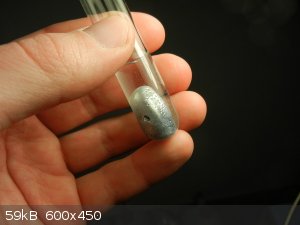
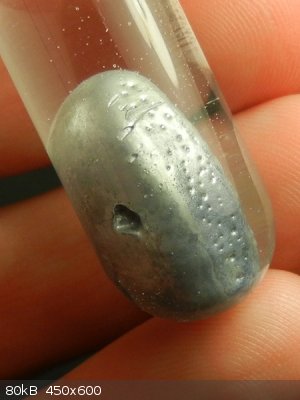
https://www.youtube.com/watch?v=WBwRnai5BMA
Reaction of residual Rb pieces with water (gif):
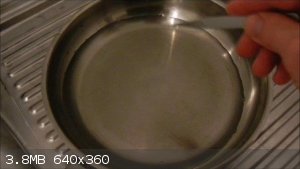
Purity and yield are not perfect, but I think it's okay for now.
The difficult part is to make solid rubidium hydroxide. It needs to be as free of sodium/potassium impurities as possible. Even tiny amounts of sodium
lower the melting point of rubidium a lot. I think my reagents weren't as sodium-free as I thought. Some sodium could also have been released from the
glass of the reaction vessel by etching. A quartz vessel and very well purified reagents should improve the purity.
[Edited on 4-2-2019 by Pok]
|
|
|
MrHomeScientist
International Hazard
    
Posts: 1806
Registered: 24-10-2010
Location: Flerovium
Member Is Offline
Mood: No Mood
|
|
This is amazing! I can't believe how versatile this catalyzed magnesium reaction is. Really excellent work, Pok. Always good to see you on the forum.
I thought Rb was one of those that catches fire in air, though? Did you notice any signs of reaction while handling it in air?
|
|
|
Pok
potassium Prometheus
  
Posts: 176
Registered: 5-12-2010
Member Is Offline
|
|
The oil-wetted rubidium behaved like oil-wetted potassium. I think it would only ignite in air if it were melted (or just above the melting point) and
completely free of oil.
I've seen some videos in which oil coated Rb and Cs were cut in air with a knife and they didn't ignite. Caesium does burst into flames when an
ampoule (with Cs free of oil) is opened near its melting point.
|
|
|
oberkarteufel
Harmless

Posts: 47
Registered: 11-12-2018
Member Is Offline
Mood: Mayonesium sulfate
|
|
First attempt to make potassium. Probably the mixture will go down the drain, in metaphorical sense.
3,5g Mg, 7g KOH, 0,5g menthol. 90 minutes after starting the reaction, no signs of K, medium oil turned very dark (baaad omen).
Possible issues:
- Medium oil contained too much of unsaturated compounds. Technical data sheet stated 1,9% of aromatics, no info on alkenes; hoped they wouldn't
meddle with the reaction. Apparently I was wrong. Used this oil because I got it for free and the boiling range was OK.
- Erlenmeyer flask used was too big compared to stir bar. Need to wait about 10 days for the ordered 100ml flask.
- Magnesium I ordered may be too coarse (1mm shavings instead of powder).
Anyway, will wait another 2 or 3 hours. The hope dies last.
|
|
|
oberkarteufel
Harmless

Posts: 47
Registered: 11-12-2018
Member Is Offline
Mood: Mayonesium sulfate
|
|
OK, repeated this again today, still no success.
This time I used liquid paraffin from pharmacy as reaction medium. Apparently a good choice, as no significant darkening was observed. Magnesium was
crushed a bit with a mortar prior to addition to the flask. This was to expose more of a fresh surface in case this was the issue. Also, menthol was
added after about an hour since the heating start.
Some evolution of gas (possibly hydrogen) was observed, no signs of shiny K 
My question to those who actually managed to produce potassium - can you try this procedure with menthol? Because at this moment I'm not sure if my
results are like this because I just didn't do it properly, or the menthol is just suitable for sodium, but not the potassium.
|
|
|
oberkarteufel
Harmless

Posts: 47
Registered: 11-12-2018
Member Is Offline
Mood: Mayonesium sulfate
|
|
Quote: Originally posted by 12thealchemist  | | have you tried heating the KOH/Mg/paraffin oil up to about 150°C until no more hydrogen is produced before then heating to 200°C? This will extend
the "reaction" time and consume magnesium, but it will dry the KOH and paraffin oil before any potassium will form. |
Thank you for the suggestion, will certainly try it. Must have omitted this detail when reading this overly long thread. I will use slightly bigger
excess of Mg also. Just to confirm, to lessen the chance of messing something again - the catalyst should be added after this initial gas generation
ceases?
|
|
|
12thealchemist
Hazard to Others
  
Posts: 181
Registered: 1-1-2014
Location: The Isle of Albion
Member Is Offline
Mood: Rare and Earthy
|
|
You are correct, the catalyst should be added once the initial gas evolution ceases. This will be when the reaction mixture is more or less dry (read:
water-free), and so the reaction should be able to take place.
Edit: I've posted a summary of this thread and NurdRage's video series here: http://www.sciencemadness.org/talk/viewthread.php?tid=104576
which may be helpful to people, if they haven't come across it.
[Edited on 5-3-2019 by 12thealchemist]
|
|
|
draculic acid69
International Hazard
    
Posts: 1371
Registered: 2-8-2018
Member Is Offline
|
|
Is replacing dioxane with diglyme a possibility?I just read it has chelating properties like dioxane,it's an ether, and has a high b.p.
|
|
|
12thealchemist
Hazard to Others
  
Posts: 181
Registered: 1-1-2014
Location: The Isle of Albion
Member Is Offline
Mood: Rare and Earthy
|
|
I don't see why it wouldn't work; I'd have tried it myself but I don't have the capabilities at the moment.
Diglyme boils at 162°C, so what about triglyme (bp 216°C)? How about it as reaction solvent?
|
|
|
draculic acid69
International Hazard
    
Posts: 1371
Registered: 2-8-2018
Member Is Offline
|
|
Hell why not tetraglyme,diglyme has the ability to resist high temp and high p.h. so I'm just guessing as I don't know about there behaviour but as
long as there chelating ability isn't altered as size increases as is with dimethyl dioxane not working as dioxane does,and assuming that chelating
ability is what we're looking for,they should definitely be looked into.worth researching.
[Edited on 31-3-2019 by draculic acid69]
|
|
|
12thealchemist
Hazard to Others
  
Posts: 181
Registered: 1-1-2014
Location: The Isle of Albion
Member Is Offline
Mood: Rare and Earthy
|
|
The only issue with tetraglyme and higher glymes is increased cost. Triglyme is the smallest that has a high enough boiling point for it to be used as
reaction solvent.
|
|
|
S.C. Wack
bibliomaster
    
Posts: 2419
Registered: 7-5-2004
Location: Cornworld, Central USA
Member Is Offline
Mood: Enhanced
|
|
Is there a superior high yielding process if the goal is only finely divided K (with MgO crud) in oil?
Quote: Originally posted by UC235  | | I had a go at the Mg/oil reduction yesterday using Mineral Oil Laxative from Walmart (Their house Equate brand). |
I was reading labels yesterday including this and IIRC the top of the label said 100% mineral oil, but the bottom said stabilized with vitamin E.
Stabilize what? The lamp oil from them was very low boiling.
Do you like old folk ranting to themselves? The only reason I went there was because I was looking for hydrated lime to make LiOH from the carbonate
with, and they had 6 brands of blood meal but apparently have no intention of selling any lime this year. Naturally one does not go to walmart for
lime but it was next to Ace, who does sell ethyl acetate still and also the 10 pound bags of lime I wanted. The analysis part says it has as much Mg
as Ca! Since when was lime made from dolomite? And so to hell with that. So as consolation I bought Nestle's refrigerated cookie dough I haven't made
for 40 years and got inedible oily blobs that do not smell, look, or taste like chocolate chip cookies. Progress, kids. Enjoy your nice TV's. Off to
continue my quest for calcium fucking hydroxide.
[Edited on 31-3-2019 by S.C. Wack]
|
|
|
draculic acid69
International Hazard
    
Posts: 1371
Registered: 2-8-2018
Member Is Offline
|
|
I've become more interested in figuring out what works and what doesn't? Cost is only going to be a deterrent to using it in place of the cheap chems
that we already know work knowledge is priceless.
|
|
|
draculic acid69
International Hazard
    
Posts: 1371
Registered: 2-8-2018
Member Is Offline
|
|
Even sigma Aldrichs price is not too ridiculous for Diglyme and tetraglyme.tetraglyme was actually cheaper!!!triglyme has been discontinued for what
ever reason.also probably wouldn't expect them to be great reaction solvents more like dioxane as purification solvents.but hey why not try it and see
what happens.
[Edited on 31-3-2019 by draculic acid69]
|
|
|
12thealchemist
Hazard to Others
  
Posts: 181
Registered: 1-1-2014
Location: The Isle of Albion
Member Is Offline
Mood: Rare and Earthy
|
|
To the best of my knowledge, this catalytic process is the best non-electrolysis method for making alkali metals for the amateur.
As for the diglyme/triglyme/tetraglyme - I was basing my prices on ebay's di/tri/tetraethylene glycol, which would require methylation however these
are very readily available. And forming the alkoxides for a Williamson's synthesis would hardly be difficult - mix with two equivalents of NaOH and
distil off the water.
|
|
|
S.C. Wack
bibliomaster
    
Posts: 2419
Registered: 7-5-2004
Location: Cornworld, Central USA
Member Is Offline
Mood: Enhanced
|
|
I am not asking about other routes to K. The question is does not having globs of K mean failure? Could the easiest, highest yielding, most
reproducible process not look like it? Like GC showing 94% yield of something in a shockingly easy synthesis in many a journal article, but good luck
actually isolating that if true. Usually the shittier procedure that ends with holding the product is more interesting to me, but it's the opposite
here.
|
|
|
12thealchemist
Hazard to Others
  
Posts: 181
Registered: 1-1-2014
Location: The Isle of Albion
Member Is Offline
Mood: Rare and Earthy
|
|
My understanding is that typically if the reaction has been successful, visible balls of potassium form which are separable. It is conceivable that
these balls do not coalesce into large globs but remain as "sand" in the magnesium oxide byproduct, but that is easy enough to test after a "failed"
reaction - careful addition to isopropanol. I also understand that simply running the reaction for longer will encourage coalescence of the potassium
balls.
|
|
|
temp_RR
Harmless

Posts: 3
Registered: 31-3-2019
Member Is Offline
|
|
Quote: Originally posted by S.C. Wack  | Is there a superior high yielding process if the goal is only finely divided K (with MgO crud) in oil?
Quote: Originally posted by UC235  | | I had a go at the Mg/oil reduction yesterday using Mineral Oil Laxative from Walmart (Their house Equate brand). |
I was reading labels yesterday including this and IIRC the top of the label said 100% mineral oil, but the bottom said stabilized with vitamin E.
Stabilize what? The lamp oil from them was very low boiling.
Do you like old folk ranting to themselves? The only reason I went there was because I was looking for hydrated lime to make LiOH from the carbonate
with, and they had 6 brands of blood meal but apparently have no intention of selling any lime this year. Naturally one does not go to walmart for
lime but it was next to Ace, who does sell ethyl acetate still and also the 10 pound bags of lime I wanted. The analysis part says it has as much Mg
as Ca! Since when was lime made from dolomite? And so to hell with that. So as consolation I bought Nestle's refrigerated cookie dough I haven't made
for 40 years and got inedible oily blobs that do not smell, look, or taste like chocolate chip cookies. Progress, kids. Enjoy your nice TV's. Off to
continue my quest for calcium fucking hydroxide.
[Edited on 31-3-2019 by S.C. Wack] |
For the Ca(OH)2 you should find a farm & garden store other than Ace. Another source is a builders or masonry store, it is used for plasters and
some other things.
|
|
|
oberkarteufel
Harmless

Posts: 47
Registered: 11-12-2018
Member Is Offline
Mood: Mayonesium sulfate
|
|
Lots of work with finding a new job (my last contract was not prolonged), so the project is currently put aside.
Unfortunately, last try was also unsuccessful. Probable issues are:
- KOH with a too high content of carbonates,
- insufficient power of a hotplate (possibly can't reach the required temperature range),
- insufficient cooling in my air-cooled Liebig's condenser, resulting with my catalyst (menthol) staying mostly there and not in the flask.
Soon some pics should arrive.
|
|
|
oberkarteufel
Harmless

Posts: 47
Registered: 11-12-2018
Member Is Offline
Mood: Mayonesium sulfate
|
|
First attempt. Look kids, this happens when your solvent contains too much aromatics:
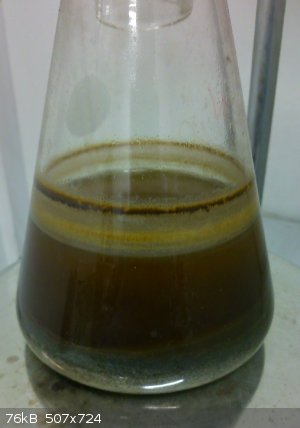
Second attempt - as we can clearly see, there are small shiny balls of molten potassium neither floating, nor merely existing in mineral oil:
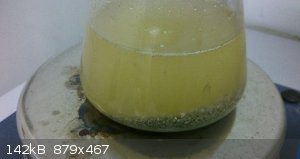
Third attempt - I got really optimistic during the "drying" step, as this time the mixture behaved differently - KOH became grey and fluffy, as gas
was evolving:
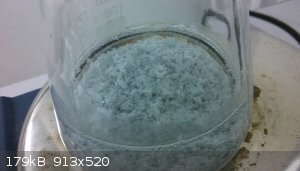
But later, when the temperature was raised and menthol added, the oil turned yellow again and no potassium formed:
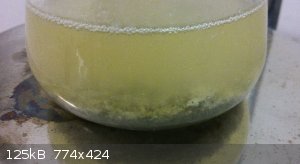
(this time, however, Mg consumption was visible.)
Also, checked the hotplate - when set to 208°C, phthalic acid (m.p. 207°C) in a beaker melted, so I am reaching the desired temperatue range. Well,
the quest continues.
|
|
|
draculic acid69
International Hazard
    
Posts: 1371
Registered: 2-8-2018
Member Is Offline
|
|
Maybe the potassium is too big too fit in the menthol molecule.have you tried t butyl or t amyl alcohol? If you get no result from that then maybe
it's your solvent.try baby oil instead of what you are using.
|
|
|
| Pages:
1
..
63
64
65
66 |